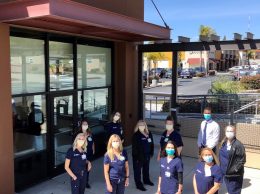Chevron has big plans for remediation and commercial development of a 332-acre plot along the Tank Farm Road corridor of San Luis Obispo. But the petroleum giant says those plans don’t pencil out unless the city agrees to a development agreement that would have taxpayers reimbursing $11.1 million of the costs.
San Luis Obispo city officials appear to be on board: They’re working with Chevron to come up with a final development agreement by early next year, and are simultaneously pushing for the currently unincorporated area to be annexed into the city limits.
“This all ties into the vision that the city of San Luis Obispo has for the build-out of the southern part of town,” said Bill Almas, the project manager for Chevron Land & Development in charge of the Tank Farm project.
The property is on either side of busy Tank Farm Road – an area long designated for development in long-term planning documents and a major east-west thoroughfare for San Luis Obispo.
Chevron says its project, which includes a business park at full build-out, will act as a catalyst for private-sector development in that portion of the city by widening Tank Farm Road to four lanes, extending Sante Fe Road to the north and south, adding traffic signals to the Tank Farm and Sante Fe intersection, and adding bicycle lanes.
Chevron’s proposal calls for developing 50 percent of the total public infrastructure in the airport specific plan, Assistant City Manager Michael Codron said, but the company is only developing 12 percent of the land in that area.
“They’re essentially building more than their fair share of public infrastructure. That eliminates the need for the city to build that infrastructure,” he said.
Chevron has said it will spend $17.4 million on regional infrastructure improvements. Its portion of the airport specific plan’s impact fees — what it will have to pay into the infrastructure pool — is $6.3 million, it says. The $11.1 million difference is what the city will have to reimburse it for, Chevron says. It has presented the city with a “menu of options” for how that amount could be refunded, including reimbursing the company with “add on” fees collected from other projects in the airport area, deferring a portion of its building-related fees, or sharing in the transient occupancy tax collected from a hotel if one were built into the project by a third-party operator. Either way, the development agreement is a slightly unconventional way for the city and a private company to partner up on a large-scale development.
Normally, the city would collect fees from private developers upfront, and then go ahead and build the surrounding infrastructure as different projects come on board. “This is a little more creative in terms of the sources of reimbursement,” Codron said.
Chevron and the city said they’d like to get a development agreement hashed out by early next year, around the same time Chevron is expected to release the environmental impact report that gets the ball rolling on the public approval process for the project.
Here’s a closer look at what Chevron wants to do:
For years, Chevron has said it wants to remediate and eventually develop a portion of the 332-acre property it owns on either side of Tank Farm Road. Over the next 25 years, the petroleum giant wants to restore the land, dedicate 250 acres to open space and eventually develop 53 acres for commercial use.
The first step is cleanup, a phase Chevron expects will take about two years. A lightning storm in 1926 sparked a massive blaze that lasted five days and boiled the crude oil stored on the site into a sticky, tar-like substance.
Chevron plans to remove that contamination, as well as the remaining crude oil storage structures on the property. Its plans also call for increasing the wetlands space and restoring the habitat for the endangered fairy shrimp — a small crustacean that held up the development of nearby Costco — and other wildlife on the property. The petroleum company says it will set up an endowment for the continued maintenance of the open space.
Suzanne Parker, a regional spokeswoman for Chevron, said the company is dedicated to cleaning the property up, and will do so whether or not its development agreement with the city pans out. “It’s important for people to know that Chevron is committed to cleaning up the property no matter what,” she said.
The portion of the project that does hinge on city cooperation is Chevron’s plans to annex the project into the city limits and develop 53 acres for commercial use — half as a business park, and half for other commercial space, such as small-business warehousing. When the commercial portion is finished sometime in the next 25 years, it will host 1,824 jobs and generate $1.6 million in annual tax revenue for the city, Chevron says. Construction would produce 534 construction jobs, the company estimates, and it would pay $10.8 million in one-time fees and sales tax to the city at the beginning.
“This is a good opportunity for the city, for the goals that are laid out in the general plan and the airport specific plan, and for growth in the southern part of the city,” Parker said.
The oil giant is also currently negotiating with the city over minimizing $2.6 million in infrastructure plan check and inspection fees, in exchange for developing the infrastructure in the airport area.
Codron and Almas went before the San Luis Obispo City Council on Sept. 20 to update the council on their plans and the potential development agreement. Codron said the City Council appeared supportive of the project. “The council by consensus gave city staff direction to move forward with a more detailed evaluation of the proposal,” he said. “Specifically, they’d also like us to consider the risks to the city associated with the reimbursement agreement.”






 Print
Print Email
Email
















